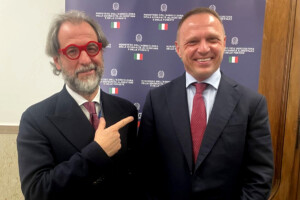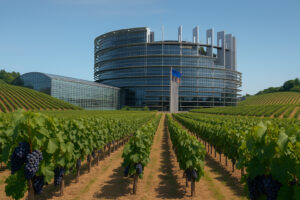What is a successful business? Judging from the perspective of the oenological world, it is the one capable of creating value over time, balancing development strategies with efficiency, focusing on the value of the brand for its customers, and putting the enhancement of the territory and, in fact, of its customers at the centre of its strategic processes, finally developing talent, without ever losing sight of the numbers. These are the contents of the study “The variables of success”, signed by Professor Luca Castagnetti, head of the DiVino Management Study Center, which analyzed, from a quantitative and qualitative point of view, the performance and peculiarities of the companies involved in VinoVip, the event signed “Civiltà del Bere” on stage in Cortina, and among the most representative of the Italian production scene.
In terms of performance, in the period 2013-2017 the total sales growth of the producers examined reached +19.18%, going from 1.73 billion euros in 2013 to 2.06 billion euros in 2017, with a better performance of the operating margin (Ebitda), equal to +30.62%, and an operating result increased, in the same period, by +48.01%. Comparing the performance of the leading wineries at VinoVip with the 168 wineries examined each year by the Mediobanca report, we can also see that in terms of Roi, or rather profitability, growth is slightly slower, equal to +5.04% in 2017 (compared to +6.60%), while Roe, or the profitability of the companies’ capital, is practically on the same lines: +6.95% in 2017, compared to +7.20% of the companies examined by Mediobanca. Another interesting aspect, which emerges from the analysis of the turnover of Professor Castagnetti, is that by dividing the sample into two groups, based on the index relating to the ratio between tangible fixed assets and total assets, whether companies invest in new vineyards or not, the Ebitda tends to be the same, and the warmth between the two groups is therefore similar. The Ebit margin of the first group (A), with an index higher than 0.4, is lower than that of group B, as the first group has a higher Capital Intensity (D&A/Ebitda), mainly due to the depreciation of tangible assets (as well as intangible assets, although to a lesser extent). In the 5 years, the growth of the Ebit of group A (+78.5%) is higher than that of group B (+48.9%), while the Net Margin of A is significantly lower than that of group B, as the companies of group A present, as it is easy to imagine, higher financial charges.
What are the strategies of a successful company? This question was answered by the entrepreneurs, and from their point of view it emerges that, in terms of development, it is fundamental to control new markets (8.95/10), thus making production processes more efficient (8.38), and integrating one’s own action with that of the grape producers involved in the transformation processes (7,95), invest in the winery (7.88), develop wine tourism and direct sales projects (7.75), develop sales with e-commerce (6.92), create partnerships with other companies to increase competitiveness (6.54) and reduce the cost of grapes and wine supply(6.32). For the customer, according to the entrepreneurs behind a successful wine there are the value of the brand (9.64), quality (9), buying experience (8.16), functionality and quality of sales and logistics (8.08) and price (7.80). Among the processes to be improved for a successful company are, therefore, the enhancement of the territory (9.36), customer loyalty (9.28), sustainability and reduction of treatments (9.20), the management of vineyards (8.84), the acquisition of new customers (8.64), winemaking (8.56), hospitality (8.40), new production techniques (8.28), logistics and distribution (8.20) and new products 8.04. Finally, among the most important managerial activities for a successful company there are the ability to develop talent (9.17), use planning and management control systems (9.12), have winemaking skills (9.00), have agronomic skills (8.84), and even team building (8.72), encourage widespread leadership (8.68), have an integrated business information system (8.64), use a CRM (8.04) and use business intelligence (7.92).
As Piero Mastroberardino, head of the Campania wine label, who received the 2019 Khail Award for his work to promote Italian wine in the world, commented, “the strength of the budget is to be expressive, in the wine world it is important to keep an eye on the data”. In a perennial search for a balance between “heart and head: certain investments in vineyards that are very difficult to make profitable”, says Alessandro Lunelli of the Trentodoc Ferrari brand, “but we do them thinking about the future, with the heart, but without losing sight of the goals”. Another interesting aspect, underlined by Raffaele Boscaini, head of Masi Agricola, in Valpolicella, is the fact that “the majority of investments in the sector take place without the help of banks, but the fact that they are essentially on the shoulders of wine families is not a good thing”. As for the enhancement of the territory, keystone in the process of enhancing the value of wine companies, Angela Velenosi gave the example of her long career as a winemaker, which has brought “to the attention of the world a name such as Rosso Conero and vines such as Passerina”. Remaining in the Marche, Michele Bernetti, guide of the Umani Ronchi winery of the Marches, underlined the role of “the Istituto Marchigiano Tutela Vino, capable of putting the needs and capabilities of large and small producers into a system”. In Chianti Classico, on the other hand, in terms of enhancing the value of the estate and the entire denomination, as Sergio Zingarelli, former president of the Consortium and owner of Rocca Delle Macìe, recounts, “in 2014, the introduction of the Gran Selezione, at the top of the Chianti Classico production pyramid, now produced by 130 estates, played a fundamental role”. In two different territories such as Valpolicella and Lugana, explains Nadia Zenato, “it will be essential to block new plants, to limit uncontrolled growth that is not good for these two great brands”. Finally, it is Sandro Bottega who offers a different point of view on the state of Italian wine, confirming that it is necessary “to make decisions, starting from the packaging. We must discover and use a different vocabulary, which allows us to communicate with the new generations, the Millennials”.
Copyright © 2000/2025
Contatti: info@winenews.it
Seguici anche su Twitter: @WineNewsIt
Seguici anche su Facebook: @winenewsit
Questo articolo è tratto dall'archivio di WineNews - Tutti i diritti riservati - Copyright © 2000/2025









































































































































































































